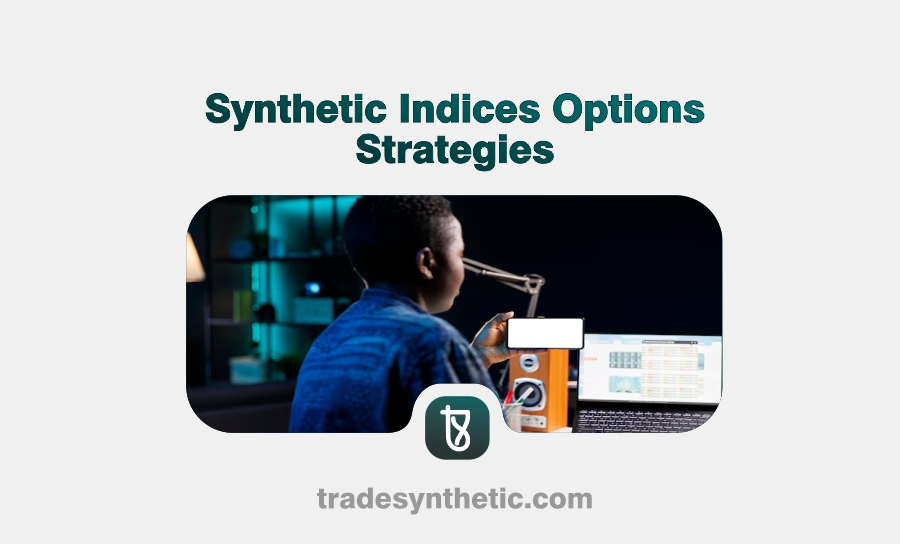Synthetic indices options strategies have become increasingly popular due to their unique market characteristics. Synthetic indices, such as the well-known Volatility 75 index, offer traders the opportunity to capitalize on price fluctuations that are not tied to traditional financial assets. These indices exhibit high volatility, which is ideal for applying options strategies.
In this article, we will discuss the options and strategies for synthetic indices, explore the tools and techniques traders use, and offer a roadmap for successfully navigating this exciting yet complex market.
What Are Synthetic Indices and How Do They Work?
Synthetic indices are unique financial instruments that simulate market movements without being tied to traditional assets like stocks or commodities. They are often used to reflect the volatility of an underlying market but do not follow any specific market directly. One of the most popular synthetic indices is the Volatility 75 index, known for its sharp price movements and high levels of volatility.
Synthetic indices operate 24/7, making them accessible for global trading. Because these indices don’t have physical commodities or stocks as their basis, they are ideal for traders who want to focus on volatility rather than market fundamentals.
- Synthetic Indices
These are digital financial products that track high volatility but do not rely on any traditional asset.
- Volatility Indices
A type of synthetic index that is especially known for its erratic and sharp price movements, making it a perfect candidate for options strategies.
Options Trading for Synthetic Indices
Options trading involves buying and selling contracts that give you the right, but not the obligation, to buy or sell an underlying asset at a predetermined price before a specified expiration date. In the context of synthetic indices, options trading allows traders to speculate on the price movements of these indices without directly holding the asset.
There are two primary types of options contracts:
- Call Options
These contracts give the trader the right to buy an asset at a specified price (strike price) within a set time frame. Traders purchase call options when they believe the price of the underlying asset will increase.
- Put Options
These contracts give the trader the right to sell an asset at a specified price within a set time frame. Trader’s purchase put options when they anticipate the price of the underlying asset will decrease.
Popular Synthetic Indices Options Strategies
Incorporating options strategies into synthetic indices trading allows traders to enhance their flexibility and risk management. Below are some of the most popular options strategies that can be applied to synthetic indices:
1. Long Call (Bullish Strategy)
The long call strategy involves buying a call option on a synthetic index when you expect the market to rise. If the price of the synthetic index moves above the strike price, the call option becomes more valuable. This is a basic yet powerful strategy to profit from upward price movements.
- When to Use: You should use the long call strategy when you believe the market is going to experience a significant upward movement. For example, if you believe that the Volatility 75 index will go up due to anticipated market changes, you will buy a call option.
- Benefits: The potential profit is unlimited, and the loss is limited to the price of the option (the premium).
2. Long Put (Bearish Strategy)
The long put strategy involves buying a put option when you expect the market to fall. A put option gains value as the price of the underlying synthetic index decreases, making this strategy ideal for a bearish market outlook.
- When to Use: This strategy works well if you anticipate a decline in the value of synthetic indices, such as when you predict that volatility will decrease or if the market is showing signs of a bearish trend.
- Benefits: The profit potential is significant if the market drops sharply, and like the long call, the loss is limited to the premium paid for the option.
3. Straddle Strategy
A straddle involves buying both a call option and a put option with the same strike price and expiration date. This strategy is employed when a trader expects high volatility but is unsure of the direction of the price movement.
- When to Use: The straddle strategy is best when you expect significant price movement in either direction but are uncertain about which direction it will take. For synthetic indices with high volatility, such as Volatility 75, a straddle can be a powerful strategy if you expect a breakout or significant price fluctuation.
- Benefits: This strategy provides the opportunity to profit from large price movements in either direction.
4. Iron Condor Strategy
An iron condor is a neutral options strategy that involves selling a lower strike put, buying a put with a lower strike price, selling a higher strike call, and buying a call with a higher strike price. This strategy profits when the market remains range-bound and does not experience significant volatility.
- When to Use: The iron condor strategy is useful when you believe the synthetic index will trade within a specific range and will not see large price movements in either direction.
- Benefits: This strategy offers a limited risk and reward, making it ideal for traders looking for steady, conservative profits.
5. Covered Call Strategy
A covered call strategy involves holding a long position in a synthetic index and selling a call option on the same index. This strategy is often used to generate additional income from the options premium when the trader believes that the market will not move above the strike price of the sold call option.
- When to Use: The covered call strategy is effective when you expect little to no movement in the synthetic index’s price but still want to profit from premium income.
- Benefits: This strategy generates income through the option premium, but it limits potential profits if the synthetic index moves sharply upwards.
Risk Management in Synthetic Indices Options Trading
While options trading can provide significant opportunities for profit, it also comes with risk. To be successful in synthetic indices options trading, it is essential to manage risks carefully. Here are a few risk management strategies to consider:
- Position Sizing
Only risk a small percentage of your total capital on each trade, such as 1-2%. This helps to avoid large losses on a single trade.
- Stop-Loss Orders
Implementing stop-loss orders is crucial to limit potential losses. These orders automatically close a trade if the market moves against your position.
- Diversification
Spread your risk across different synthetic indices and strategies to reduce the impact of a single loss.
- Use of Leverage
Be cautious when using leverage, as it can magnify both profits and losses. Always use leverage responsibly.
Conclusion
Synthetic indices options strategies offer traders a unique way to capitalize on volatility and price movements in markets that do not directly correlate with traditional assets. By employing strategies like long calls, straddles, and iron condors, traders can navigate synthetic indices markets effectively.
However, just as important is managing risk carefully through position sizing, stop-loss orders, and leveraging options responsibly. It is not enough to Know these strategies, applying them correctly can significantly improve your success when trading synthetic indices.
Frequently Asked Questions (FAQs)
What are synthetic indices?
- Synthetic indices are digital financial products that mimic the behavior of a highly volatile asset. They are not based on traditional commodities or stocks but simulate price fluctuations in the market. Examples include the Volatility 75 index and other volatility indices.
How do options strategies work with synthetic indices?
- Options strategies, such as long calls, puts, and straddles, can be used with synthetic indices to profit from price movements. These strategies help traders take advantage of volatility and price swings, which are characteristic of synthetic indices.
What is a straddle strategy?
- A straddle strategy involves buying both a call and a put option with the same strike price and expiration date. It is used when traders expect significant price movement but are uncertain of the direction.
What is the best strategy for trading synthetic indices?
- The best strategy depends on the trader’s market outlook and risk tolerance. For example, a long call is ideal in a bullish market, while a long put works better in a bearish market. Strategies like straddles and iron condors are great for volatility and neutral market conditions.
How can I manage risk when trading synthetic indices options?
- Risk management strategies include using stop-loss orders, limiting the amount of capital risked on each trade, and diversifying across different synthetic indices and options strategies.










